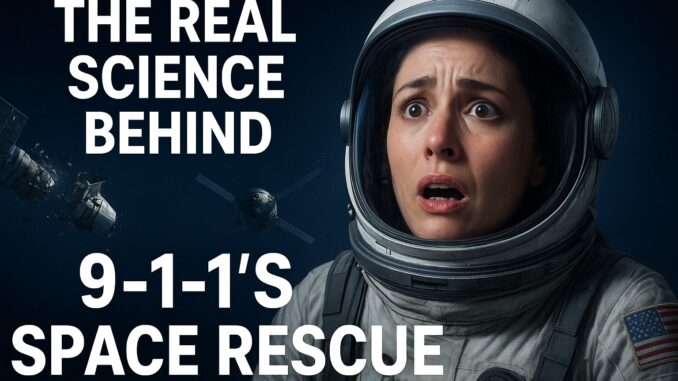
If you’re a fan of 9-1-1, you already know the show loves pushing adrenaline levels to the max. But when the series ventured beyond Earth with a high-stakes space rescue, viewers worldwide began asking the same question: Is any of this even remotely possible?
Believe it or not, the science behind space-based rescue missions isn’t as far-fetched as you might think. While Hollywood definitely adds extra flair, some elements of the show reflect real technologies, real physics, and real challenges astronauts face. In this deep-dive, we’ll explore the real science behind the show’s boldest storyline and break down whether a space rescue like 9-1-1 portrayed could realistically happen.
Understanding the Concept of a Space Rescue
What Counts as a “Space Rescue”?
A space rescue involves assisting astronauts who are stranded, injured, or at risk due to spacecraft malfunctions, medical emergencies, or environmental hazards. Think of it as emergency response—just without gravity, air, or margin for error.
Why Hollywood Loves This Setting
Space has always been the ultimate “what-if” playground. Every second counts, danger is relentless, and even simple problems can turn catastrophic. It’s perfect for drama, but the science behind it is far from fiction.
Could First Responders Actually Go to Space?
Trained Astronauts vs. First Responders
Contrary to what shows like 9-1-1 depict, firefighters or paramedics can’t just jump into a rocket and launch. Astronauts train for years in:
-
Microgravity simulation
-
Advanced medical procedures
-
Engineering and spacecraft operation
-
Survival situations
Why You Need Specialized Training
In space, even treating a minor injury becomes a challenge. Fluids float. Tools drift. Blood doesn’t drip—it forms spheres. So, unless your local fire station secretly includes astronaut training, Hollywood takes some liberties here.
The Physics of a Space Rescue Mission
Can Another Spacecraft Reach a Damaged One?
Here’s the cool part: yes, but with limitations.
Orbital Mechanics Matter
You can’t just “fly straight toward” another spacecraft. Instead, you must:
-
Match its orbital altitude
-
Match its orbital speed
-
Approach at centimeter-per-second precision
A rescue craft must perform calculated burns while maintaining a safe trajectory—one mistake could cause catastrophic collision.
The Real-Life Example—Apollo 13
NASA executed a near-impossible mission to bring astronauts home safely after a mid-space explosion. It wasn’t a rescue ship scenario, but it was a rescue mission.
Could a Civilian Space Launch Happen on Short Notice?
The Reality of Launch Preparation
A rocket launch takes weeks—sometimes months—of planning.
Reasons a Rapid Launch Is Unrealistic
-
Weather constraints
-
Engine testing
-
Safety clearance
-
Orbital alignment
-
Supply preparation
Even SpaceX, known for rapid innovation, cannot launch an unplanned emergency flight within hours.
The Medical Side—Treating Injuries in Microgravity
How the Human Body Responds to Injury in Space
Space changes everything:
-
Blood pools in the head
-
Swelling increases
-
Immune response weakens
-
Bones become fragile
Why Medical Tools Need Reinvention
Regular stretchers? Impossible. Needles? They behave differently. Even CPR becomes complicated without gravity.
NASA’s Microgravity CPR Technique
Astronauts anchor their feet on a surface while pushing against the patient—almost like doing pushups to create chest compressions.
Communication Challenges in a Space Rescue
Delay is Inevitable
Even in low Earth orbit, communication delays can reach fractions of a second. In deeper space, the delay can be minutes.
Why This Matters
Emergency responders rely on instant guidance. In space, the crew must often rely on:
-
Pre-trained procedures
-
Automated systems
-
Onboard software
Technology That Could Make Space Rescues Real One Day
Autonomous Docking Systems
SpaceX, NASA, and the ESA already have automated docking systems—critical for rescue missions.
Space Ambulance Concepts
NASA and private companies have proposed the idea of medical modules that could serve as:
-
Emergency escape pods
-
Mobile treatment centers
-
Return capsules
AI-Assisted Medical Tools
Future spacecraft could include:
-
Robotic surgical arms
-
AI medical assistants
-
Real-time diagnostics
What Did 9-1-1 Get Right?
Realistic Elements
-
The danger of debris and microgravity
-
The isolation astronauts face
-
Communication tension
-
High-stakes time sensitivity
Where Hollywood Added Magic
-
Emergency civilian space launches
-
Quick astronaut training
-
Real-time rescue coordination
-
On-the-spot spacecraft maneuvering

So… Could a Space Rescue Like 9-1-1’s Actually Happen?
The Short Answer
Not today—but maybe in the future.
What Needs to Change First?
-
Faster launch systems
-
Dedicated rescue spacecraft
-
Space-based emergency personnel
-
Advances in medical robotics
-
Space station networks
We’re not there yet, but humanity is closer than ever.
Conclusion
The space rescue portrayed in 9-1-1 blends real scientific principles with Hollywood excitement. While the idea of everyday first responders leaping into rockets isn’t realistic, the core concepts—orbital maneuvers, spacecraft docking, astronaut emergency response—are grounded in legitimate science.
As space travel becomes more common, the possibility of implementing true space rescue systems grows. Someday, we may have dedicated “space paramedics” or orbit-ready emergency vehicles, making missions like the one on 9-1-1 more science than fiction.
